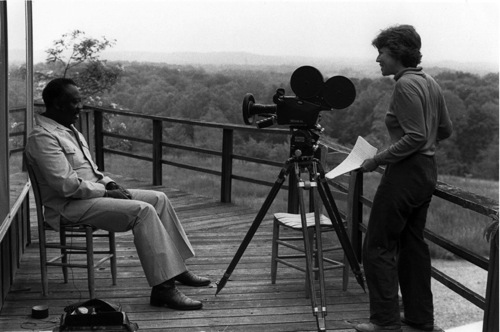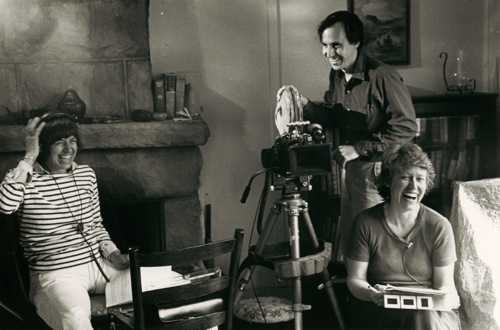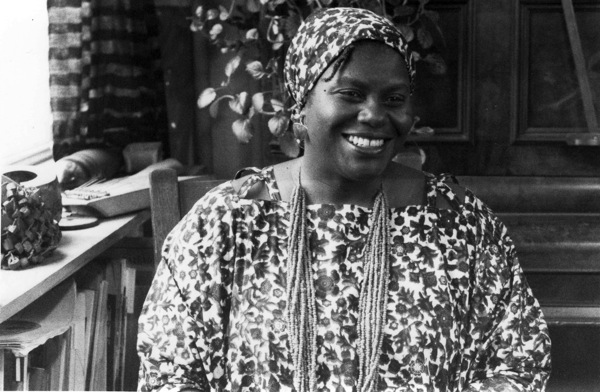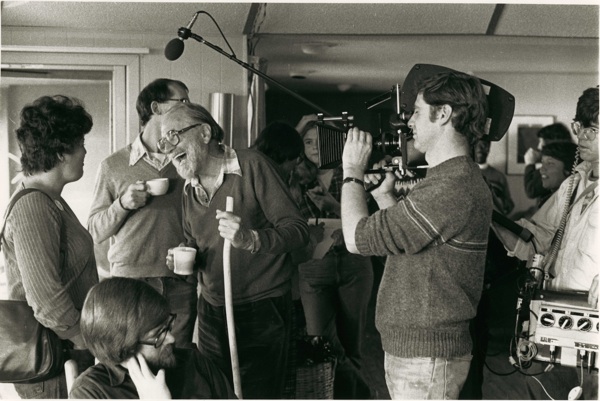 Introduction
Introduction
Everyone brings their own personal baggage to the movies, and I don’t think I’m alone in treating them too readily as literature. Much of the vocabulary we apply to film comes from long-ago high school English classes. We assume that every detail is a puzzle piece that leads inexorably to a deliberate display of thematic unity and artistic expression. Analyze this film, we’re asked, and we begin to point out a camera movement like it’s an enjambment in a poem. We’re blessed with a bag of critical tools but we apply them as if every work is a self-contained thing that we can understand without leaving the house.
Luckily, there are some films that demand a different kind of engagement and derive the whole of their meaning and impact from what we do with them afterwards. They can’t exist without oxygen. Every Oscar season we’re inundated with films that we’re assured are ‘inspiring’ in a non-threatening, heart-warming sort of way (witness The King’s Speech, War Horse, or this year’s Flight), but it’s another thing to talk about a film that aspires to instigate its audience to action. (I like especially the card that ends the second part of Hour of the Furnaces, Fernando Solanas’s four-and-half-hour essay film about the history of neocolonialism and resistance in Argentina: “Intermission—for debate.”)
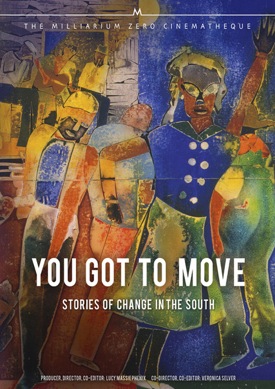 For the past seven years, Amy Heller and Dennis Doros have been working to resurrect a forgotten strand of agitational American political films through the Milliarium Zero imprint of their distribution company Milestone. Winter Soldier, the first Milliarium Zero release from 2005, documents a landmark 1971 hearing organized by Vietnam Veterans Against the War. It’s a film with such unimpeachable moral clarity that it makes every other war film I’ve seen look tremulous and small. (Winter Soldier is also a film record of the short-lived rectitude of John Kerry, who offers sharp testimony about Vietnam atrocities in a cameo; his performance is a universe removed from the uncritical military pageantry that engulfed his 2004 Democratic National Convention.)
For the past seven years, Amy Heller and Dennis Doros have been working to resurrect a forgotten strand of agitational American political films through the Milliarium Zero imprint of their distribution company Milestone. Winter Soldier, the first Milliarium Zero release from 2005, documents a landmark 1971 hearing organized by Vietnam Veterans Against the War. It’s a film with such unimpeachable moral clarity that it makes every other war film I’ve seen look tremulous and small. (Winter Soldier is also a film record of the short-lived rectitude of John Kerry, who offers sharp testimony about Vietnam atrocities in a cameo; his performance is a universe removed from the uncritical military pageantry that engulfed his 2004 Democratic National Convention.)
Following Winter Soldier, Milliarium Zero handled theatrical distribution for UCLA’s restoration of Word Is Out: Stories of Some of Our Lives, an oral history of queer Americans who had outgrown, outlasted, and overcome the closet. Long before LGBTQ became a standard acronym, Word Is Out already demonstrated that label’s inadequacy. (And right now, Milestone is also raising funds to restore another cinematic artifact that explodes received notions of queer history: Shirley Clarke’s Portrait of Jason, the shaggy dog monologue of a singularly self-contemplating male hustler.)
It only makes sense, then, that Milliarium’s latest release, You Got to Move: Stories of Change in the South, charts society’s advance through the self-empowerment of everyday people. Its co-director, Lucy Massie Phenix, who also contributed to the collective productions of Winter Soldier and Word is Out, spoke with us last week about the film and its implications for present-day political problems.
KW: Let’s start out by talking about why you made the film.
LMP: The film was made to be an organizing film. I’m sure that there are many other factors involved, because I wanted it to be a really good film in the time that it was made. But the film was always meant to be a film that inspired people to go out and get involved themselves. I think of it still as an organizing film, even though it’s about a time that is now historical. So when it’s shown, it’s really nice to have it shown in the context of people going out and using it and to find their own role in the change that we’re challenged to make in these times. And that’s the reason I’m so happy that you’re showing it.
LMP: In 1980, I had just finished editing The Life and Times of Rosie the Riveter. I was learning a lot about propaganda, especially propaganda during the Second World War. A lot about unions during that time. But I also was very aware that we were moving into a different era because of the election of Reagan. I happened to go to a conference organized by the Physicians for Social Responsibility on the medical consequences of nuclear weapons and nuclear war.
That was something that was very much in the forefront of our consciousness then. It wasn’t just Reagan. Carter had just signed the First Strike Initiative, which said that we would make a first strike in a nuclear confrontation. I got very, very affected by that conference when I went to it. I was already feeling pretty powerless. I was wondering whether making films was the way I could be most effective in bringing about change.
Shortly after that, Myles Horton came out to lecture for a few days at the University of California at Berkeley. I had been involved with the Civil Rights movement and had gone to the Highlander Folk School back in the mid-’60s, so I knew Myles. It was what he said when he came out here that made me realize that Highlander’s work had always addressed itself to the question of people coming into their own power. It started out with unions in the South in 1932 and even the organization of unemployed workers in Grundy County, Tennessee. Highlander had always addressed itself to people who wanted to move on their own power and also really wanted to feel their own power.
The influence and philosophy behind Highlander really had to do with bringing people together to analyze what their powerlessness consisted of. Analyze what was going on in their communities, and analyze what could be done, who were the forces at work, and what part it is that the people in the community wanted to effect.
I thought, ‘This is worthy. This  is what I want to make a film about. How do people who feel powerless come to realize that they are empowered?’ And I had that question because I felt it myself and I think that’s a perennial question. It comes up with all of us from time to time.
is what I want to make a film about. How do people who feel powerless come to realize that they are empowered?’ And I had that question because I felt it myself and I think that’s a perennial question. It comes up with all of us from time to time.
KW: In the years since the film came out, do you think these questions have changed? Sometimes our era seems more receptive to this kind of discourse but in other ways, more hostile. Union busting is now a bipartisan political tactic.
LMP: I’m glad you’re showing it now because I think we’re in another place like that. It’s certainly relevant for people looking at what has been happening and what is right now happening with unions. We’ve just come from an election where we have to say we have a very divided country.
KW: It wasn’t an accident that we scheduled You Got to Move for the first weekend after the election. Of course, we didn’t know the outcome when we made the booking. Either people would be very discouraged and have a lot to organize about or be happy and—
LMP: Still have a lot to organize about.
KW: Exactly.
LMP: As soon as the election was over, the work has become for me, and for the people around me, how do we organize now to put pressure on Obama? How do we organize to understand the forces on him so that the pressure we apply can really be creative? How do we move from here? We can’t get stuck by any of this. I’m not at all interested anymore in the election. I could look at it and analyze it, and I’m sure that’s what the pundits are doing, but to me it looks like I learned a lot from what happened with Occupy.
I can’t speak from experience, because I wasn’t really involved in Occupy, but if you’ve been following what’s been going on in Far Rockaway, where Hurricane Sandy was really devastating, it was the Occupy people who really knew how to come in there and help the local people because some of the Occupy people were the local people. How to get organized and deliver what people needed, including food and flashlights and diapers. How to make a relevant response to a real crisis.
We really need to work across the traditional divides and discover the ways that people in communities can come together to make changes. Redefine what the ‘we’ is, as Myles put it.
We also have to redefine what it is that we’re doing. There’s this fiscal cliff that they say we’re on. And we’re not on a fiscal cliff. This country isn’t broke. People are being robbed. But as long as they define it as the fiscal cliff, we’re accepting other people’s definition of our struggle. I think this film has the power to make people see beyond.
 KW: Can you talk about the distribution that You Got to Move received after you finished it in 1985?
KW: Can you talk about the distribution that You Got to Move received after you finished it in 1985?
LMP: It was never distributed well enough. It was screened at the York Cinema in San Francisco. There were places that it was screened—not big theaters, but university settings and community settings. It’s never been on public television and I think that’s a real shame. At one point, the MacArthur Foundation selected You Got to Move for inclusion in its Library Video Classics Project, which meant that they put copies in every public library with a circulating VHS collection. That’s the way that it was really most widely seen at the time.
As soon as VHS was defunct and before DVD came in, You Got to Move was just not seen by anybody. People would contact me and see if they could use a copy. That’s why it was so wonderful that Milestone wanted to pay for the remastering and get it out on the DVD.
Over the last year, I’ve been talking about new strategies for getting it out to people, too, including streaming it on the web, because that’s how people do things now. But we can’t ignore the old ways of getting it out. It was shot on 16mm and it was always shown in 16mm. That’s how it was. I’m not interested in that for nostalgic reasons.
KW: Right now we hear about how digital is this very democratic medium that allows people from all walks of life with a very small investment to create media and agitate. That’s very true, but at the same time, there’s so much hubbub about that, we get a very skewed sense of the past and how widely 16mm was used and how flexible its use was and how varied its audience was.
LMP: I don’t think young people really get it at all. The most obvious thing that comes to mind is how people are all walking around with their phones and watching YouTube on their phones and everyone is watching it by themselves and they send a link to someone else. It’s wonderful that it can move so quickly through the population, but it takes away the power of an audience.
One of the places that we showed the film that was most effective to me was at the American Friends Service Committee downtown meeting. Maybe six or seven years ago. There were all of these young organizers there from the Latino community who just didn’t know that history. But it wasn’t just what people were learning about the subject, but the fact that they were learning it together in the same room. The room just crackled with people who wanted to tell stories to each other and talk about strategy for organizing. That’s why I made it.
If people in the audience have any ideas about the use of the film now, I want to hear from them. It’s not a historical piece, but about bringing history into the fore to make use of it. I hope it’s useful.
The Northwest Chicago Film Society will screen You Got to Move: Stories of Change in the South on Sunday, November 11 at 6:00 and 8:30pm at Cinema Borealis, 1550 N. Milwaukee Ave. The 8:30pm screening will be accompanied by a discussion with film critic and Highlander alumnus Jonathan Rosenbaum. The film will be screened in the only circulating 16mm print. Special thanks to Amy Heller, Dennis Doros, and especially Lucy Massie Phenix.

